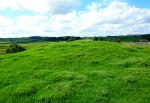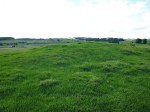NGR: TQ 27382 86518. A large Bronze Age bowl burial mound on Hampstead Heath, Greater London, which has trees and bushes growing from it and railings surrounding it, was tradi-tionally called ‘Boadicea’s Grave’, however, this often given assumption is considered to be a myth and has no historical association with Boadicea or Boudicca, Queen of the Iceni. She was the widow of King Prasutagus, who died in late 59 or early 60 AD. The circumstances of Boadicea’s death, the place of her death, and the place of her burial sometime around 61 AD is not known (some historians put her death a few years later on) although several theories have been put forward as to where she was buried in Londinium and further afield, though without any real evidence to back up those claims. Did she: take her own life? was she killed by a Roman soldier? was she poisoned? did she succumb to ill health or did she escape alto-gether, never to be seen again? – in truth though, these questions cannot be answered and probably never will be answered, but she is almost certainly not buried in the ancient tree-covered mound on Parliament Hill (Hampstead Heath) which predates her by 1,000 years or more. A second mound close by was built in the last few hundred years and was probably the site of a fire beacon.
Hampstead Heath is 4 miles northwest of the city. A very splendid bronze monument-cum-statue of the Celtic warrior Queen Boudicca stands on the Embankment close to Westminster Bridge in London, where she is shown riding her horse-drawn chariot with her two daughters at her side, and scythes on its wheels! This statue group was made in the late Victorian age, but not erected until 1902. The Latin form of her name was always written by Roman writers as BOUDICCA.
James Dyer writing in 1977 says of the barrow on Parliament Hill, Hampstead Heath, that it is: “Covered by bushes, halfway between Hampstead Ponds and Highgate Ponds. This barrow, now obscured by bushes and enclosed by iron railings, is about 41 m in diameter and 2.4 m high, with an encircling ditch about 4.9 m wide. In 1894 Sir Hercules Read trenched the mound but found nothing in it. Some doubt has been cast on its antiquity, but a sketch made by Stukeley in May 1725 leaves little room for scepticism. His drawing clearly shows a causeway across the ditch on the north side, and another is reported on the south.”
Similarly, perhaps, ‘The King’s England — London’ tome from 1949 gives the following information on Boadicea’s Grave: “To the north stretch Parliament Hill Fields, the glorious extension of Hampstead Heath with hundreds of acres of grassy parkland. From the top of the hill, 320 feet high, is an extensive all-round view. with the churches of Hampstead and Highgate, and the Surrey hills across the Thames. A short distance from the summit is the little artificial hill called Baodicea’s Grave, now hidden in trees and undergrowth. It is 10 feet high and nearly 40 yards across, and is surrounded by a dry ditch. It is thought to be a grave of the early Bronze Age, and thus about 4000 years old. The mound on the north side has been added in the last two centuries, and was probably formed by beacon fires.”
Geoffrey Ashe wrote in 1993: “Boudicca’s campaign was not an act of resistance to conquest, but a reaction after the event. Her career illustrates the equality of Celtic queens, and their ability to take charge and command armies. Her name, perhaps an assumed one, means ‘Victory’, and her attachment to the war-goddess Adraste may hint at a religious quality in her leadership. She is described as tall, fierce-looking, and harsh-voiced, with a mass of red hair down to her waist.
“Her personal grievances are obvious, and so are her public ones, since the Romans made it plain that they were annexing her territory and not letting her continue as queen. She could enlist the Trinovantes – no longer subject to the Catuvellauni — because of the Romans’ treatment of Camulodunum in the course of its transformation into Colchester. Army veterans seized land by evicting Britons in possession, and the authorities extorted money and labour for a building programme such as no Briton could have foreseen……”
Ashe goes on to say: “Boudicca, therefore, exploited the indignation of the whole of East Anglia, a populous area. Late in the year 60 AD, probably, a horde of Britons under her leadership destroyed Colchester. The Roman forces in Britain were divided, and she captured London and Verulamium, burning both to the ground and massacring thousands, not only Roman but British collaborators. Rome’s historians take her triumphs no further, but there are archaeological hints of outbreaks beyond.
“The governor, Suetonius Paullinus, was away in Anglesey stamping out Druids. During 61 he managed to assemble ten thousand men, and stationed them in a well-chosen spot, partly enclosed by hills and woods that nullified the Britons’ advantage in numbers. Its location is doubtful. One suggestion puts it near Towcester, in Northamptonshire; another near Mancetter between Nuneaton and Atherstone. The queen attacked, but Roman discipline prevailed and the Britons were routed. Her suicide may well be historical, and there is certainly no clue to her grave. The King’s Cross theory is due to Lewis Spence, who conjectured that she fought her last battle on the future site of the station.
“Paullinus carried out ruthless reprisals. However, his treasury officer Classicianus was a Gaul with ideas about Romanisation. Under his influence the regime grew milder, and the Britons, those of the upper classes at least, were largely reconciled and assimilated.”
The idea that Queen Baodicea was buried at Stonehenge in Wiltshire is a myth as is King’s Cross railway station in London, where it has been suggested by some that her body lay beneath platforms 8, 9 or 10! It’s possible the Queen’s body was taken back to her native East Anglia and cremated and buried somewhere in Norfolk.
Sources/References & Related Websites:-
Ashe, Geoffrey, Mythology Of The British Isles, Methuen, London, 1993.
Dyer, James, Southern England — An Archaeological Guide, Faber And Faber Limited, London, 1977.
Richmond, I. A., The Pelican History Of England — Roman Britain, Penguin Books Limited, Harmondsworth, Middlesex, 1963.
The King’s England, London — Heart of the Empire and Wonder of the World, Hodder And Stoughton, London, 1949.
https://www.megalithic.co.uk/article.php?sid=4724
https://en.wikipedia.org/wiki/Boudica
https://www.historic-uk.com/HistoryUK/HistoryofEngland/Boudica/
More info here: https://www.visitnorfolk.co.uk/post/romans-boudicca-and-the-iceni-in-norfolk
Copyright © Ray Spencer, The Journal of Antiquities, 2024.







